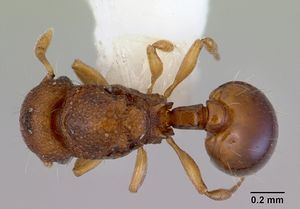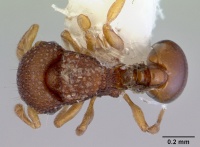Mayriella transfuga
| Mayriella transfuga | |
|---|---|

| |
| Scientific classification | |
| Kingdom: | Animalia |
| Phylum: | Arthropoda |
| Class: | Insecta |
| Order: | Hymenoptera |
| Family: | Formicidae |
| Subfamily: | Myrmicinae |
| Tribe: | Crematogastrini |
| Genus: | Mayriella |
| Species: | M. transfuga |
| Binomial name | |
| Mayriella transfuga Baroni Urbani, 1977 | |
M. transfuga was described by Baroni Urbani (1977) from material collected in Bhutan and Nepal. It is now known to occur much more widely, being found from Nepal and India east to Hong Kong and the Philippines and south to Borneo and Java, Indonesia. The majority of records are from primary and secondary rainforests where workers have been found foraging in leaf litter or nesting in soil.
Identification
This taxon can be separated from other species in the genus by the presence of well developed sculpturing in the posterior section of the scrobe, the large, closely spaced pits on the mesosomal dorsum, the parallel lateral surfaces of the postpetiole, the strongly angular petiolar node and the relatively long propodeal spines (length greater than 1.5 times the width of their bases). It is most similar to Mayriella granulata but can be separated based on the longer and narrower propodeal spines. (Shattuck and Barnett 2007)
Distribution
Latitudinal Distribution Pattern
Latitudinal Range: 32.628611° to -5.066666667°.
| North Temperate |
North Subtropical |
Tropical | South Subtropical |
South Temperate |
- Source: AntMaps
Distribution based on Regional Taxon Lists
Indo-Australian Region: Borneo, Indonesia, Malaysia, Philippines, Singapore.
Oriental Region: Bhutan, India, Laos, Nepal (type locality), Thailand.
Palaearctic Region: China.
Distribution based on AntMaps
Distribution based on AntWeb specimens
Check data from AntWeb
Countries Occupied
| Number of countries occupied by this species based on AntWiki Regional Taxon Lists. In general, fewer countries occupied indicates a narrower range, while more countries indicates a more widespread species. |

|
Estimated Abundance
| Relative abundance based on number of AntMaps records per species (this species within the purple bar). Fewer records (to the left) indicates a less abundant/encountered species while more records (to the right) indicates more abundant/encountered species. |

|
Biology
Species of Mayriella show strong preference for moist, forested areas. Most specimens have been collected from rainforest or wet sclerophyll woodlands with relatively few collections from dry sclerophyll or scrub habitats (and these are restricted to Australia). Nests are normally found in soil under stones or with a small mound of loose dirt at the entrance. They have also been found nesting in rotten logs and occasionally arboreally. The number of workers in nests averages between 50 and 100 and about one-half of the nest series containing queens contain more than one, suggesting that species are polygynous. Foraging workers are most commonly collected from litter samples. Nests appear to be locally abundant although patchily distributed on a larger scale. For example, in the Brindabella Ranges near Canberra, ACT, Mayriella ebbei is infrequently encountered and is known from only a few localities. However, near Baroomba Rocks (located on the eastern slope of the Brindabella Ranges) M. ebbei occurs commonly under rocks in an area covering several hundred square meters. This population appears limited to this small area as nests could not be found in areas with similar geography and vegetation located several kilometers away. However, observations are limited and additional data will be required to determine if these habits are widespread and/or occur in other species. Additionally, while Taylor (1961) made similar observations for Mayriella abstinens, these were based on the introduced population found in New Zealand and should be confirmed for naturally occurring populations of the genus. (Shattuck and Barnett 2007)
Castes
Worker
  
| |
| . | Owned by Museum of Comparative Zoology. |
Queen
Images from AntWeb
   
| |
| Queen (alate/dealate). Specimen code casent0172446. Photographer April Nobile, uploaded by California Academy of Sciences. | Owned by ANIC, Canberra, Australia. |
Nomenclature
The following information is derived from Barry Bolton's Online Catalogue of the Ants of the World.
- transfuga. Mayriella transfuga Baroni Urbani, 1977a: 411, figs. 1, 2 (w.) NEPAL, BHUTAN.
- Type-material: holotype worker, 8 paratype workers.
- Type-locality: holotype Nepal: Terai Dist., 6 km. NW Narainghat, 250 m., 30.v.-1..vi.1976 (C. Baroni Urbani); paratypes with same data.
- Type-depositories: NHMB (holotype); BMNH, NHMB (paratypes).
- Status as species: Bolton, 1995b: 249; Zhou, 2001b: 97; Shattuck & Barnett, 2007: 449 (redescription); Pfeiffer, et al. 2011: 47; Guénard & Dunn, 2012: 44; Bharti, Guénard, et al. 2016: 38; Jaitrong, Guénard, et al. 2016: 36.
- Distribution: Bhutan, China, India, Indonesia (Kalimantan), Laos, Malaysia (Peninsula, Sabah, Sarawak), Nepal, Philippines (Luzon), Singapore, Thailand.
Unless otherwise noted the text for the remainder of this section is reported from the publication that includes the original description.
Description
Worker
Shattuck and Barnett (2007) - Sculpturing in posterior section of antennal scrobe well developed and distinct; sculpturing on dorsal surface of mesosoma consisting of large, closely spaced pits; propodeal spines relatively long and thin; dorsal surface of petiole in lateral profile uniformly convex, without distinct dorsal and posterior faces and forming a sharp angle with the anterior face; in dorsal view, postpetiole with the anterior and posterior regions approximately the same width (the region connecting them either flat or weakly convex); postpetiole and gaster lacking erect hairs dorsally.
Measurements. Worker (n = 10) - CI 0.95-1.01; HL 0.40-0.46; HTL 0.20-0.23; HW 0.39- 0.45; ML 0.41-0.47; PW 0.28-0.35; SI 0.49-0.61; SL 0.22-0.25.
References
- Baroni Urbani, C. 1977a. Ergebnisse der Bhutan-Expedition 1972 des Naturhistorischen Museums in Basel. Hymenoptera: Fam. Formicidae Genus Mayriella. Entomol. Basil. 2: 411-414 (page 411, figs. 1, 2 worker described)
- Cantone S. 2018. Winged Ants, The queen. Dichotomous key to genera of winged female ants in the World. The Wings of Ants: morphological and systematic relationships (self-published).
- Dendup, K.C., Dorji, C., Dhadwal, T., Bharti, H., Pfeiffer, M. 2021. A preliminary checklist of ants from Bhutan. Asian Myrmecology 14, e014005 (doi:10.20362/am.014005).
- Jansen, G., Savolainen, R. 2010. Molecular phylogeny of the ant tribe Myrmicini (Hymenoptera: Formicidae). Zoological Journal of the Linnean Society 160(3), 482–495 (doi:10.1111/j.1096-3642.2009.00604.x).
- Khachonpisitsak, S., Yamane, S., Sriwichai, P., Jaitrong, W. 2020. An updated checklist of the ants of Thailand (Hymenoptera, Formicidae). ZooKeys 998, 1–182 (doi:10.3897/zookeys.998.54902).
- Shattuck, S.O. & Barnett, N.J. 2007. Revision of the ant genus Mayriella (pp. 437-458). In Snelling, R.R., Fisher, B.L. & Ward, P.S. (eds). Advances in ant systematics: homage to E.O. Wilson – 50 years of contributions. Memoirs of the American Entomological Institute 80:690 pp.
- Subedi, I.P., Budha, P.B. 2019. Status of ant research and species first described from Nepal with new distribution records. Journal of Natural History Museum. 31:57-78.
- Subedi, I.P., Budha, P.B., Bharti, H., Alonso, L. 2020. An updated checklist of Nepalese ants (Hymenoptera, Formicidae). ZooKeys 1006, 99–136 (doi:10.3897/zookeys.1006.58808).
- Wang, W.Y., Soh, E.J.Y., Yong, G.W.J., Wong, M.K.L., Benoit Guénard, Economo, E.P., Yamane, S. 2022. Remarkable diversity in a little red dot: a comprehensive checklist of known ant species in Singapore (Hymenoptera: Formicidae) with notes on ecology and taxonomy. Asian Myrmecology 15: e015006 (doi:10.20362/am.015006).
References based on Global Ant Biodiversity Informatics
- Bharti H., Y. P. Sharma, M. Bharti, and M. Pfeiffer. 2013. Ant species richness, endemicity and functional groups, along an elevational gradient in the Himalayas. Asian Myrmecology 5: 79-101.
- CSIRO Collection
- Guénard B., and R. R. Dunn. 2012. A checklist of the ants of China. Zootaxa 3558: 1-77.
- Huang Jian-hua, Zhou Shan-yi. 2007. A checklist of family Formicidae of China - Myrmicinae (Part II) (Insecta: Hymenoptera). Journal of Guangxi Normal University : Natural Science Edition 25(1): 91-99.
- Jaitrong W., B. Guenard, E. P. Economo, N. Buddhakala, and S. Yamane. 2016. A checklist of known ant species of Laos (Hymenoptera: Formicidae). Asian Myrmecology 8: 1-32. DOI: 10.20362/am.008019
- Li Z.h. 2006. List of Chinese Insects. Volume 4. Sun Yat-sen University Press
- Pfeiffer M.; Mezger, D.; Hosoishi, S.; Bakhtiar, E. Y.; Kohout, R. J. 2011. The Formicidae of Borneo (Insecta: Hymenoptera): a preliminary species list. Asian Myrmecology 4:9-58
- Shattuck S. O., N. J. Barnett. 2007. Revision of the ant genus Mayriella. Memoirs of the American Entomological Institute 80: 437-458.
- Taylor R. W. 1991. Nomenclature and distribution of some Australasian ants of the Myrmicinae (Hymenoptera: Formicidae). Memoirs of the Queensland Museum 30: 599-614.
- Tian M., L. Deharveng, A. Bedos, Y. Li, Z. Xue, B. Feng, and G. Wei. 2011, Advances of cave biodiversity survey: a result based mainly on invertebrates. Proceedings of the 17th National Congress of Speleology, Yinshuidong, Hubei, 1-3 Nov 20111, p 149-163.
- Woodcock P., D. P. Edwards, R. J. Newton, C. Vun Khen, S. H. Bottrell, and K. C. Hamer. 2013. Impacts of Intensive Logging on the Trophic Organisation of Ant Communities in a Biodiversity Hotspot. PLoS ONE 8(4): e60756. doi:10.1371/journal.pone.0060756
- Woodcock P., D. P. Edwards, T. M. Fayle, R. J. Newton, C. Vun Khen, S. H. Bottrell, and K. C. Hamer. 2011. The conservation value of South East Asia's highly degraded forests: evidence from leaf-litter ants. Phil. Trans. R. Soc. B. 366: 3256-3264.

